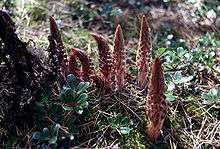Allotropa
| Allotropa virgata | |
|---|---|
 | |
| Scientific classification | |
| Kingdom: | Plantae |
| (unranked): | Angiosperms |
| (unranked): | Eudicots |
| (unranked): | Asterids |
| Order: | Ericales |
| Family: | Ericaceae |
| Subfamily: | Monotropoideae |
| Genus: | Allotropa Torr. & Gray |
| Species: | A. virgata |
| Binomial name | |
| Allotropa virgata Torr. & Gray | |
Allotropa virgata is in the family Ericaceae (Heath Family) and is the only species of the genus Allotropa. It is a perennial plant that gets its common names from the distinct white and red or maroon stripes along its erect peduncle. A. virgata are nongreen as they lack chlorophyll, instead obtaining nutrition from neighboring green plants through a fungal intermediate. Allotropa virgata feeds exclusively on Matsutake mushroom mycelium.
Its common names include Sugarstick, Sugar-stick, Candystriped allotropa and Barber's Pole.
Range
Allotropa virgata is found in the oak, coniferous and hardwood forests of the Pacific Northwest. It grows from 75 to 3000 meters in elevation in the High Sierra Nevada, High Cascade Range and up through British Columbia. There is also suitable habitat in Idaho and Montana.
Morphology
A. virgata has an underground stem (rhizome) with brittle roots. The scale-like leaves are along the striped peduncle with a raceme-like inflorescence. The peduncle is persistent after the seeds have been dispersed and tends to turn brown. The bracts of the inflorescence are less than 3 cm and the pedicels are not recurved.
The individual flowers generally don’t have sepals but if they do, have 2 to 4. Often the petals of the flower are incorrectly considered sepals. The corolla has 5 white petals in a cup shape, all petals are free and concave. From the corolla there are 10 protruding stamens, maroon in color, with dehiscent anthers. The superior ovary has 5 chambers with a style under 2 mm and a disk-like stigma. The short nectary is disk-like as well with 10 lobes.
The fruit of A. virgata are capsules which dehisce lengthwise through the ovary wall near the center of each of the 5 chambers. This dehiscence allows the many fusiform seeds from each chamber to be dispersed.
Sources
- Hickman, J.C. 1993. The Jepson Manuel: Higher Plants of California. University of California Press: 545
- www.calflora.org
- Photo gallery